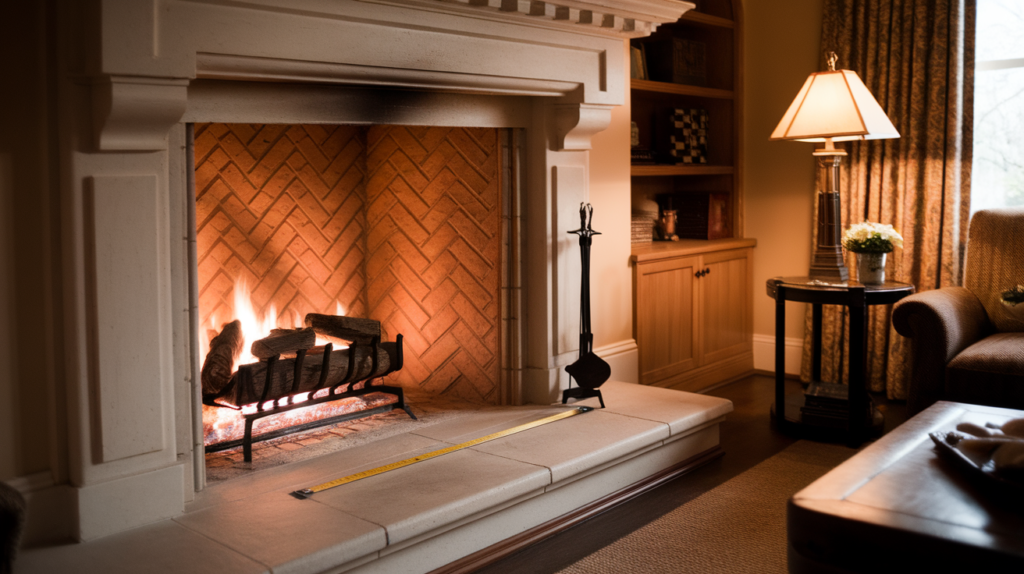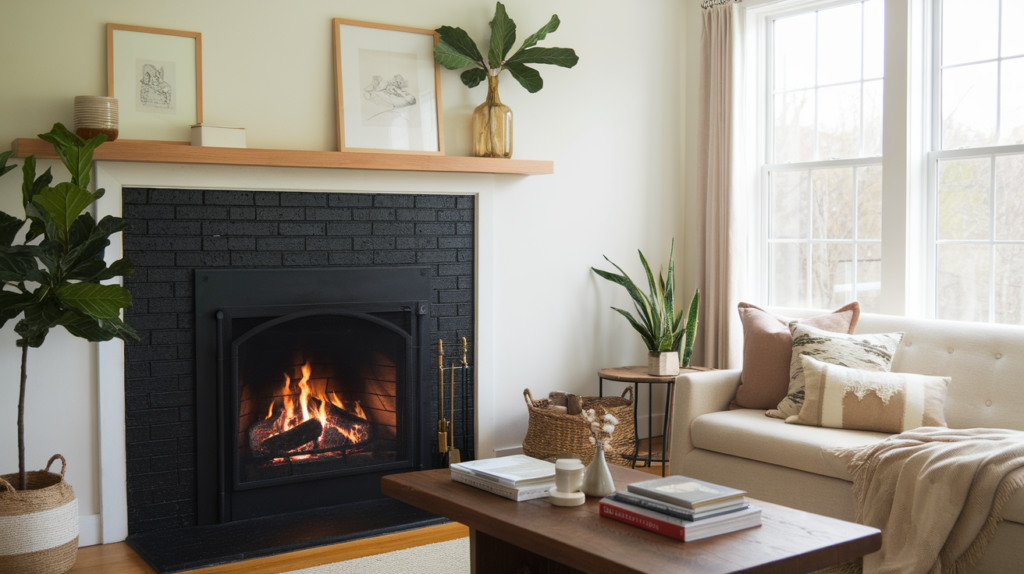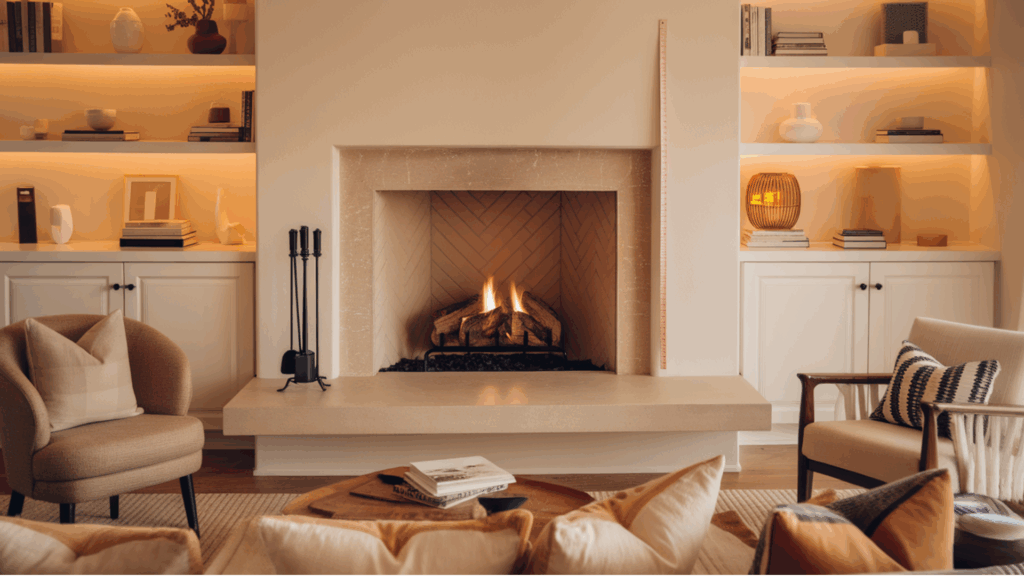Picking the perfect fireplace hearth height might seem like a small detail, but it makes a massive difference in your home’s comfort and style.
Many homeowners overlook this critical design element, not realizing how much it impacts both safety and visual appeal.
Why does hearth height matter so much?
- It influences the overall look of the room
- Determines comfort and functionality
- Influences seating and viewing angles
If you’re renovating or building from scratch, the right hearth height can change your space.
My guide will walk you through everything you need to know – from standard measurements to personal considerations that make your fireplace truly yours.
I’ll solve your hearth height puzzle, breaking down complex decisions into simple steps.
My guide will walk you toward a fireplace that looks great and works perfectly for your home.
What Is a Fireplace Hearth?
A fireplace hearth is the area around the fireplace, typically made of heat-resistant materials like stone, brick, or tile. It serves both a functional and decorative purpose.
Functionally, the hearth protects the surrounding floor from heat, sparks, and soot. It helps prevent damage to the flooring and keeps the fire safely contained.
Decoratively, it adds to the overall look of the room and enhances the fireplace’s appeal. The hearth often extends in front of the fireplace, but it can also surround it, depending on the design.
If you’re using your fireplace for warmth or as a centerpiece, the hearth plays an important role in both safety and style.
Standard Fireplace Hearth Height

The standard height for a fireplace hearth is typically 4 to 6 inches above the floor.
- Protection: This height helps protect the surrounding area from heat and debris while keeping the fire contained.
- Level: The hearth should be level with the bottom of the firebox to ensure safety and efficiency.
- Design Variations: In some designs, the hearth may be a bit higher, especially in more traditional or custom-built fireplaces.
If the hearth is raised too high, it can create an awkward step, but if it’s too low, it may not offer sufficient protection.
When planning a hearth, it’s important to consider both safety and comfort, ensuring it blends well with the overall room design while serving its practical function.
Key Factors to Consider with Fireplace Dimensions
Choosing the right hearth isn’t a one-size-fits-all decision. Let me walk you through the critical considerations that’ll help you nail your fireplace design.
1. Fireplace Style Matters
The style of your fireplace influences the hearth height. Traditional fireplaces usually need taller, more substantial hearths, while modern designs tend to favor sleeker, lower profiles.
The hearth should complement the overall look of the room, just like the perfect shoes match an outfit. Make sure it fits the style of your space.
2. Room Proportions Rule
The size of the room matters when choosing a hearth. A small room can feel cramped with a large hearth, while a large room might look odd with a small one.
Think of the hearth like furniture – it should match the proportions of the space. Smaller rooms benefit from lower, compact hearths, while larger rooms can handle taller ones.
3. Safety First
Always consider safety clearances. Building codes are in place for a reason, and most regulations require a specific distance between the hearth and flammable materials.
Ensure your hearth meets these safety requirements to keep your home safe.
4. Mantel
The mantel can play a big role in deciding hearth height. Some mantels are designed to work best with certain hearth heights.
The mantel and hearth need to look balanced together, so think about how the mantel will sit in relation to the hearth when planning the height.
5. Furniture and Functionality
Think about how you’ll use the space around the hearth. Will you be able to place a coffee table or arrange chairs comfortably?
The hearth should look good and be practical. Ensure it suits your lifestyle and doesn’t block furniture arrangements or make the space uncomfortable.
Pro Tip: Always measure and visualize before installing the hearth. Planning ahead will help make sure everything fits and works well in your living space.
When to Seek Professional Advice?
Here are some situations where it’s better to call a professional for your fireplace project:
- Complex Structural Challenges: Older homes or rooms with unusual layouts can be tricky. If your space has special requirements, a professional can help avoid costly mistakes.
- Building Code Issues: Fireplace installations often have strict local regulations. A professional will know the right codes and make sure your installation is up to standard.
- Custom Design Projects: If you’re aiming for a unique, custom fireplace, you’ll need an expert. Professionals can turn your ideas into a safe and functional design.
- Safety Concerns: Incorrect installations can be dangerous. Professionals understand ventilation, materials, and heat distribution, keeping everything safe.
- Saving Money: DIY mistakes can be expensive to fix. Hiring a pro can actually save you money in the long run by getting the job done right the first time.
Pro Tip: Always get multiple quotes. A good professional will take the time to explain their process and answer your questions.
Raised vs. Floor-Level Fireplace Hearths: What’s the Difference?
Let’s break down the two main hearth styles in a clear, easy-to-understand comparison:
| Feature | Raised Hearths | Floor-level Hearths |
|---|---|---|
| Height | 4-14 inches above the floor | Completely level with the floor |
| Visual Impact | Creates a dramatic focal point | Sleek, minimalist appearance |
| Safety Pros | More protection from sparks | Modern look, fewer tripping hazards |
| Safety Cons | Potential tripping risk | Less ember protection |
| Best For | Traditional homes | Modern, minimalist spaces |
| Seating Comfort | Less comfortable seating is nearby | Easier furniture placement |
| Installation Complexity | More complex | Simpler construction |
| Recommended Rooms | Living rooms, formal spaces | Open-concept areas, small rooms |
Think of hearths like shoes for your fireplace – some are high heels, some are comfy flats. Your room’s personality matters most. A cozy cottage might love a raised hearth, while a sleek apartment might prefer floor-level.
Design Strategies for Great Hearths
Ready to turn your fireplace from basic to brilliant? Let’s see some design strategies that’ll make your hearth the star of the room.
1. Theme Integration
Your hearth should blend with the overall style of your room. Think of it as part of the bigger picture. If your room has a rustic feel, stone might be the right choice.
For a modern look, sleek materials like concrete could work better. Match the hearth to the room’s vibe to create a cohesive look.
2. Material Magic
Materials play a big role in setting the tone of your space. Brick adds a classic touch, marble gives a luxurious feel, and concrete suits modern designs.
Choose materials that complement the rest of your room while making sure they feel right for the atmosphere you want to create.
3. Furniture Friendship
The height of your hearth affects how the space feels. If it’s too high, seating might feel awkward; too low, and it could be hard to see the fire.
Aim for a height that makes the room comfortable, encouraging people to sit around and enjoy the space naturally.
4. Storage Superpowers
Your hearth doesn’t just serve as a place for fire; it can also provide hidden storage. Consider adding built-in shelves for books or compartments for blankets and fire tools.
This practical addition not only looks great but also keeps things organized and accessible.
5. Focal Point Finesse
The hearth can become the room’s focal point. A raised hearth, for example, can make the fireplace stand out and create a dramatic visual.
The right height and placement of the hearth can turn it into a room’s centerpiece, drawing attention where you want it most.
Common Mistakes to Avoid when Determining Hearth Height

Let’s talk about fireplace fails. I’ve seen enough hearth horror stories to fill a book. Here’s how to dodge the most common design disasters.
- Ignoring Safety Clearances: A hearth that’s too low can cause heat damage, while one that’s too high may create tripping hazards. Follow safety codes.
- Furniture Placement Issues: Incorrect hearth height can make furniture placement awkward and disrupt the room’s flow.
- Style Mismatch: Ensure your hearth height matches your room’s style—modern spaces need different heights than traditional ones.
- DIY Mistakes: DIY hearth installation can lead to fire risks and costly repairs. Professional help is often needed.
- Room Size Imbalance: Choose a hearth size that suits your room. Too small in a large room or too big in a small one feels off.
Conclusion
Picking the right hearth height is an important decision that affects both the safety and style of your space.
If you’re going for a raised or floor-level hearth, it’s essential to consider factors like room size, furniture placement, and the overall design of your room.
Always follow safety codes and think about how the hearth will fit with your furniture and decor. If you’re unsure, don’t hesitate to seek professional help to avoid costly mistakes.
With the right planning and design, your hearth will not only be functional but also enhance the beauty of your home.
Take your time and enjoy creating the perfect fireplace setup!

